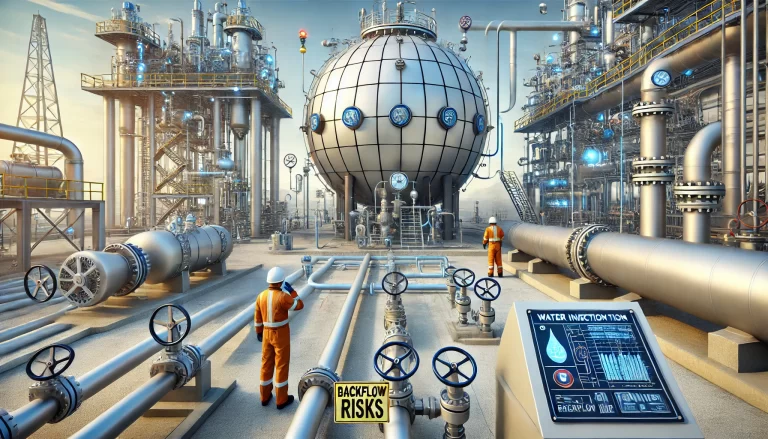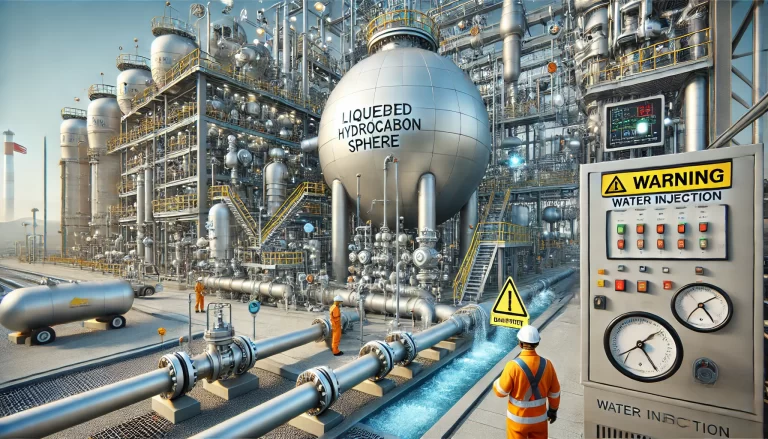Introduction
Liquefied hydrocarbon (LH) sphere tanks play a critical role in the storage and handling of volatile hydrocarbons such as propane, butane, and other liquefied petroleum gases (LPG). The water injection system in these tanks is used for emergency cooling, hydrostatic testing, and fire suppression. However, one of the significant risks associated with these systems is backflow or reverse flow, where hydrocarbons unintentionally enter the water system, leading to potential safety hazards, environmental contamination, and operational inefficiencies. This article provides an in-depth analysis of backflow risks and effective prevention and control measures.
Understanding the Backflow Risk
Backflow in a water injection system occurs when there is a pressure imbalance that causes liquefied hydrocarbons to reverse into the water system. Several factors contribute to this risk:
Pressure Differences: If the water system pressure drops below the internal pressure of the sphere tank, hydrocarbons can backflow into the water lines.
Faulty Valves: Malfunctioning or improperly installed check valves can fail to prevent reverse flow.
Pipeline Corrosion and Leakage: A compromised pipeline can lead to unexpected pressure variations, increasing the likelihood of backflow.
Human Error: Inadequate operational control, such as improper valve sequencing, can introduce backflow risks.

Preventative Measures
To mitigate the risk of backflow, a combination of engineering controls, operational best practices, and maintenance protocols must be implemented.
1. Engineering Design Controls
Installation of High-Quality Check Valves:
Use non-return valves with high backpressure tolerance.
Ensure redundant check valve arrangements for added safety.
Use of Physical Isolation Measures:
Implement dual-valve isolation systems (e.g., double block and bleed valves).
Consider water seal traps to create a liquid barrier between the hydrocarbon and water systems.
Pressure Regulation and Monitoring:
Ensure that the water injection pressure is consistently higher than the internal pressure of the sphere tank.
Install pressure transmitters and alarms to detect abnormal conditions.
Automated Emergency Shutoff Systems:
Deploy automated shutoff valves linked to pressure sensors.
Integrate real-time monitoring systems to detect and respond to potential backflow conditions.
2. Operational Best Practices
Strict Valve Operation Procedures:
Ensure that water injection is conducted at the correct pressure.
Sequence valve opening and closing properly to avoid pressure drops.
Regular Water System Drainage:
Periodically drain and flush the water injection system to remove any residual hydrocarbons.
Maintain system integrity by avoiding stagnant water in pipelines.
Emergency Response Drills:
Train personnel on backflow emergency procedures.
Conduct simulation exercises to reinforce response capabilities.
3. Routine Maintenance and Inspection
Valve Testing and Maintenance:
Perform routine inspections and functional tests on check valves and shutoff valves.
Replace or repair faulty components immediately.
Pipeline Integrity Checks:
Conduct ultrasonic or pressure integrity testing to detect leaks or weaknesses in water pipelines.
Use corrosion-resistant materials to prolong pipeline life.
Regular Pressure Testing:
Periodically test water system pressure to ensure compliance with operational standards.
Calibrate pressure monitoring equipment to maintain accuracy.

Emergency Response and Mitigation
Despite all precautions, emergencies can still occur. A robust emergency response plan should include:
Gas Detection and Alarm Systems:
Install hydrocarbon gas detectors in critical locations.
Ensure immediate alerts are triggered if hydrocarbons are detected in the water system.
Immediate Shutoff Protocols:
Designate emergency shutdown valves that can be remotely or automatically activated.
Maintain manual emergency shutoff access points.
Contingency Planning and Recovery:
Establish a mitigation plan to handle contaminated water.
Coordinate with environmental and safety agencies for spill response.
Conclusion
Preventing backflow in liquefied hydrocarbon sphere tank water injection systems is essential for ensuring operational safety, protecting the environment, and maintaining regulatory compliance. By integrating robust engineering controls, enforcing strict operational procedures, and conducting regular maintenance, industries can significantly reduce the risk of hydrocarbon contamination in water systems. Additionally, emergency response preparedness is critical to mitigating the impact of any accidental backflow incidents. Implementing these measures not only enhances safety but also improves the overall reliability of the water injection system.
